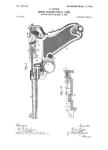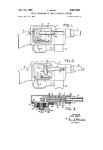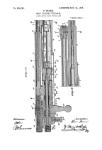/
Tags: weapons military affairs patent
Year: 1908
Text
P. MAUSER.
HEOOIL LOADING SMALL ASM.
APPLICATION FILED APE. 29, 1908.
903 998. Patented Nov. 17,1908.
3 SHEETS-SHEET 1.
INVENTOR :
W/TtfESSES :
P. MAUSER.
EECOIL LOADING SMALL AEM.
APPLICATION FILED APE. 29, 1908.
903,998.
Patented Nov. 17,1908.
3 SHEETS-SHEET 2.
INVEN T OR:
P. MAUSER.
EECOIL LOADING SMALL ABM.
APPLICATION FILED APE. 29, 1908.
903,998.
Patented Nov. 17,1908.
3 SHEETS-SHEET 3.
/V/ TMESS ES :
INVENTOR:
UNITED STATES PATENT OFFICE. .
PAUL MAUSER, OF OBERNDORF-ON-THE-NECKAR, GERMANY.
RECOIL-LOADING SMALL-ARM.
No. 903,998. Specification of Letters Patent. Patented Nov. 17, .19'08.
Application filed. April 29, 1908. Serial No. 429,992.
To all whom it may concern:
Be it known that I, Paul Mauser, royal
commercial councilor, a subject of the King
of Wiirtemberg, residing at, Oberndorf-on-
5 the-Neckar, in the Kingdom of Wiirtem-
berg, Germany, have invented certain new
and useful Improvements Relating to Re-
coil-Loading Small-Arms, of which the fol-
lowing is a full, clear, and exact description.
10 In hitherto known automatic loading
weapons with changeable magazines the ' r-
rangement is such that, after the last car-
tridge in the magazine has been fired off, the
rearwardly moved breech bolt is retained in
15 its rearward position by the cartridge feed
plate or by a special arresting member,
thereby indicating to the marksman that the
magazine in the weapon is empty and must
be replaced by a full one.. This exchange
20 of the empty magazine for a full one is, as
. is well known, easy and rapid pin order,
however, to prepare the weapon again for
firing, it is necessary with the devices hither-
tb known to partly or completely pull back
25 the breech bolt and allow it again to advance
in order to push a cartridge info the barrel.
This movement takes more- time than the
simple exchange of a magazine, as the
weapon has to be turned round or to be put
30 from one hand into the other and then back
again; this has been found to be a draw-
back, the removal of which is the object of
the present invention.
t Every self loading weapon after having
SS fired the last cartridge, must be ready for
loading and, after the fitting thereto of a
new magazine, must be again immediately
ready for firing; the manner in which this
requirement is complied with isehownin the
40 accompanying drawings as applied, for. ex-
ample, to a self loading pistol, “Mauser’s
system ”.
Figure 1 shows the right hand side of the
pistol, partly in section to show the novel
45 parts, the last cartridge out of the magazine
and in the barrel ready for firing. Fig. 2
shows the breech holt held back in the usual
way by the cartridge feed plate, after the last
cartridge in the magazine has been fired off,
50 the empty magazine being still in the
weapon. Fig. 3 shows the breech bolt held
back by the cartridge ejector after the
removal of the empty magazine from the
weapon. Fig. 4 is a section on line I—I of
55 Fig. 1, looking in the direction of the arrow.
Fig. 5 is a section on line II—II of Fig. 3
looking in the direction of the arrow. Figs.
6 to 9 show details.
By referring to Figs. 1 to 5 it will be seen
that the spring ejector u, a detent &, and 60
the magazine holder d. are mounted at the
'side of or behind each .other in the stock A
(that is, that part on which the barrel В
with the breech casing C is slidably mounted
and guided) immediately at the rear limit 65
of the magazine ajferture. The detent Ъ is ,
influenced by the spring fy and forms in its.
co-action with the spring ejector a on the
one hand and the changeable magazine D on
the other hand, the main feature of this, in- 70
vention.
Supposing the various parts of the weapon
to be in the position shown in Fig. I, all the .
parts will have assumed the position shown
in Fig. 2 after the last cartridge has been 75.
delivered from the magazine, that is to say,
the cartridge feed plate p of the magazine
D, by the action of the feed spring Z thereon,
passes in front of the rearwardly projected
breech bolt E and prevents, as is well kpown, 80
this latter from advancing to its locked posi-
tion. If the empty magazine is now re-
moved from the weapon to be replaced by a
full one, the breech bolt would, in the usual
way,.be released from the feed plate, arid 85
consequently resiime its closed position.
This is the known operation as described
at the .beginning of this specification and
which is disadvantageous because the weapon,
is not ready for firing after the full maga- 90
zine has been introduced, for the reason.'
first of all, that the breach bolt has to be
pulled back by -hand until it is able to en-
gage the uppermost cartridge and push it
.into the barrel. Attempts have already 95
been made, by introducing special arresting
members", to meet this drawback, but they,
have only succeeded so far that the breech
bolt has not had to be pulled back the whole
distance of its working movement but only 100
a short distance in order to be released from
the member holding it and to be able to
push a cartridge from the new full maga-
zine into the barrel.
The saving of time by this means is, how- Ю5
ever, so slight that it is not worth the ar-
rangement provided, as a special handle is
necessary for drawing back the breech bolt,
whether for a greater or smaller distance.
According.to the present in”ention the ar- HO
rangement is such that after the last car-
tridge has been, delivered by the magazine,
803,008
the breech bolt is held back by the feed plate
of the magazine in the same manner as here-
tofore, (Fig, ,1) ; the breech bolt, however,
does not immediately advance to its closed
5 position after the removal of the empty
magazine but is held fast by the spring
ejector «, as shown in Fig. 3, until it is re-
leased from the latter by the fitting of a new
full or empty magazine, when, in advancing
10 to its closed position, it simultaneously
pushes a fresh cartridge out of the magazine
into the barrel. This is effected by the mov-
ability of the spring ejector (which does not
hinder the freedom of movement of the
15 breech bolt when shooting and when a maga-
zine is in.the weapon) being interrupted
when the magazine is removed by means of
a detent Ъ until a new magazine is intro-
duced. When this has been done the ejector
20 again obtains its spring movement and is
then able to eject the empty cartridges.
The details necessary for the above de-
scribed operation are shown in Figs. 6 to 9.
Fig. 6 shows the ejector a, which, contrary
25 to the form hitherto adopted, has only one
laterally projecting nose a1, under which the
detent о (Fig. 7) passes when the free'move-
ment of the ejector is to be temporarily in-
terrupted. The magazine holder d (Fig. 8),
30 which holds the magazine in the weapon in
known manner, and the detent Ъ are both in-'
fiuenced by a duplex spring f (Fig. 9). The
arrangement of these parts in the weapon
and their action will be understood by refer-
35 ring to the drawing.
The ejector is constantly pressed upwards
by its spring a2. if it is not, as shown in Fig.
1, held down by the breech bolt while the lat-
ter is in its closed position; if, however, the
40 breech bolt is in its open position, the ejector
is able to pass onto a notch or recess pro-
vided for this purpose in the underside of
the fore part of the breech bolt (Fig. 2) and
is again pressed down by the following clos-
45 ing movement of the breech.bolt if not mean-/
while held by the intervention of a special
detent Ъ and thereby prevented from any
downward movement. This latter takes
place when the empty magazine is taken out
50 of the weapon in order to be replaced by a
full one (Fig. 3). The detent &, which, by
a projection c on the rear wall of the maga-
zine, was held against the pressure of the
spring f in the position shown in Fig. 1, is
55 released from the resisting action of the pro-
jection e, and, by the pressure of the spring /,
is caused to pass with its upper end b1 under
the nose a1 of the ejector a; the latter is
thereby prevented 'from moving downwards
60 and consequently holds the breech bolt in its
rearward (open) position, (instead of it be-
ing held by the feed plate which was re-
moved with the magazine) until the pro-
jection c of a newly introduced filled maga-
zine again presses back the detent Ъ, where- 65
upon the ejector is released by the latter and
the breech bolt is capable of advancing with-
out hindrance to its closed position during
which it simultaneously pushes the upper-
most cartridge out of tne magazine into the 70
barrel. The weapon is now in the condition
shown in Fig. 1, ready for firing again.
What I claim as my invention, and desire
to secure by Letters Patent is: •
1. In a self-loading small arm having a 75
detachable magazine, a device for automatic-
ally putting the weapon in readiness for fir-
ing when changing magazines, comprising a
spring ejector for holding the breech bolt
back when the magazine is removed, a detent 80
for engaging said ejector, said detent being
adapted to be disengaged from said ejector
by a fresh magazine whereby the breech bolt
can resume its closed position and thereby
push a cartridge from the magazine into the 85
barrel.
2. In self-loading small arms, the combi-
nation With the breech bolt of an ejector hav-
ing a projecting nose, a notch or recess in the
underside of the nose of the breech bolt into 90
which the ejector can pass, a spring-pressed
detent, and a projection on the magazine
which holds the detent against the action of
its spring, which detent, when the magazine
is removed, is pressed forward so as to come 95
under the nose of the ejector when the latter
has risen into the notch or recess in the
breech bolt and the latter is in the fully open
position.
3. In a fire, arm having a breech bolt, a de- 100
tachable magazine, means Operated by the
magazine for holding back said breech bolt
when the magazine is empty, means for hold-
ing back said breech bolt when the magazine
is removed, and means for releasing said last 105
named means when a fresh magazine is in-
troduced.
4. In a fire arm having a breech bolt, a de-
tachable magazine having means for holding
back said breech bolt when the magazine is 110
empty, and a catch mechanism adapted to be
interposed in the path of said breech bolt
when the magazine is removed, so as to hold
said breech bolt in its open position, and
means connected with the magazine for re- 115
leasing said catch mechanism when a fred;
magazine is introduced.
In fitness whereof, I have hereunto signed
my name in the presence of two subscribing
witnesses.
PAUL MAUSER.
Witnesses:
Henry Hasper,
Woldemar Haupt.



